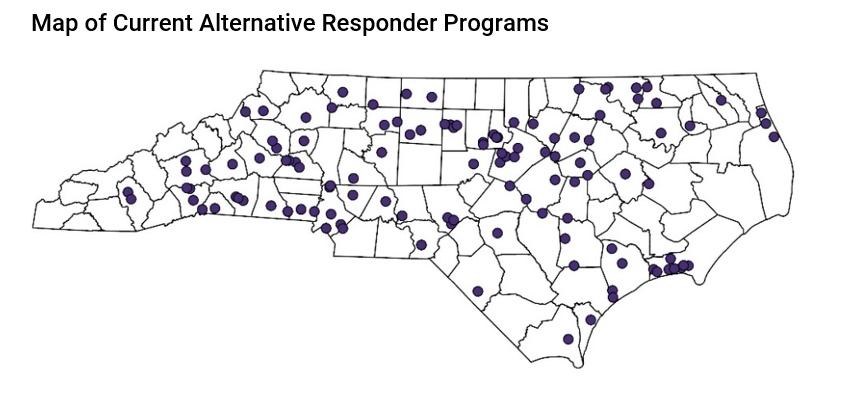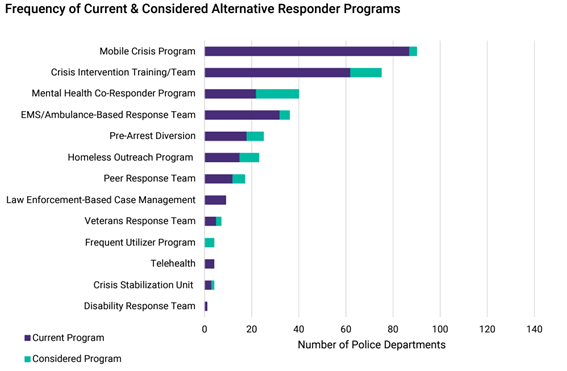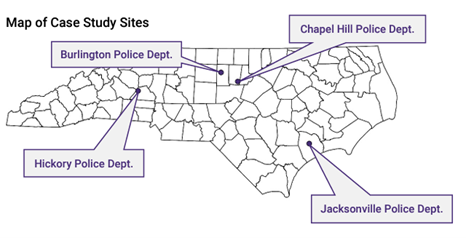Law enforcement and the communities they serve want effective responses to crime and other problems. They want policing that promotes safety and trust. And they want alternative responses for behavioral and social problems—to safely connect people to services that address root causes of behavior while allowing law enforcement to focus on solving and preventing violent and serious crime. While individual police departments and other community organizations have begun implementing alternative responder programs, there is no common understanding of how many communities are doing so or what the programs are.
To address that knowledge gap, the UNC School of Government Criminal Justice Innovation Lab (the Lab) partnered with the North Carolina Association of Chiefs of Police (NCACP), to execute the Alternative Responder Project. Through a survey of NCACP members, follow-up interviews, and case studies of four departments’ programs, our project report provides information about existing and planned-for alternative responder programs in North Carolina and recommendations from communities engaging in this work. This blog post summarizes some key project takeaways.
But first, an explanation—what are alternative responder programs? Alternative responder programs can take multiple forms. They can be police department-based programs, like crisis intervention teams, homeless outreach programs, and case management programs, where specially trained staff respond to crisis calls and/or follow up with individuals in crisis. They can be community-based programs, like mobile teams of mental health, disability, or social service staff that respond to calls alone or in partnership with medical professionals. And they can be co-responder programs, where mental health, substance use, or social service staff respond with law enforcement to calls for services.
Police departments and community organizations across the state have implemented and are interested in a variety of alternative responder programs. Of the 142 departments that responded to the survey, 83% report having at least one alternative responder program, either housed in the department or at another community organization. The map below shows the geographic distribution of current programs in North Carolina. Notably, programs are reported throughout the state, in rural, suburban, and urban communities.

The figure below shows the frequency of current and considered alternative responder programs. Mobile crisis programs are the most common existing programs. The greatest interest for the future is in mental health co-responder programs.

Programs use varied staffing strategies. Alternative responder programs are staffed by a variety of professionals, including mental health professionals, substance use treatment providers, social workers, paramedics and EMS, and peer support specialists. Staff can be embedded within police departments or at a partner organization.
Alternative responder programs offer a range of benefits. In interviews, departments and their partners identified many benefits, including connecting people to services, reducing repeat calls for service and officer use of force, and improving efficiency and effectiveness of law enforcement resources. Stakeholders note that these programs alleviate pressures officers face when responding to crisis calls, and program staff often offer counseling services—whether formally or informally—to officers as well.
Service availability limits effectiveness. Programs are not without their challenges. In particular, limited local services and resources, like housing and behavioral health services, constrain programs’ potential to address root causes of behavior and interrupt the cycle of crisis calls.
Departments and partners have concrete recommendations for new programs. They include starting with an assessment of local needs and resources, building officer buy-in, securing sustainable funding, and starting small and adapting over time. More recommendations from the four case study sites are in the project report.

What’s Next?
We’ve already started Phase 2 of the project: an empirical evaluation of one or more alternative responder programs to help stakeholders understand their impact.